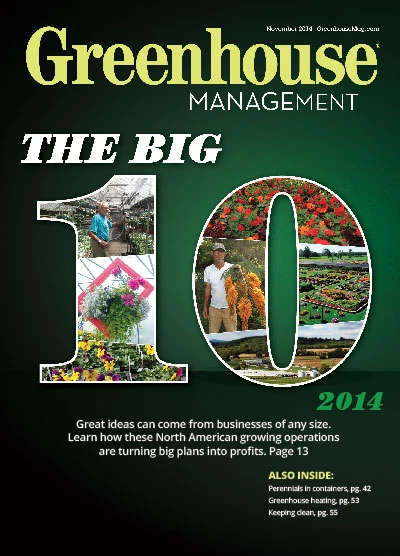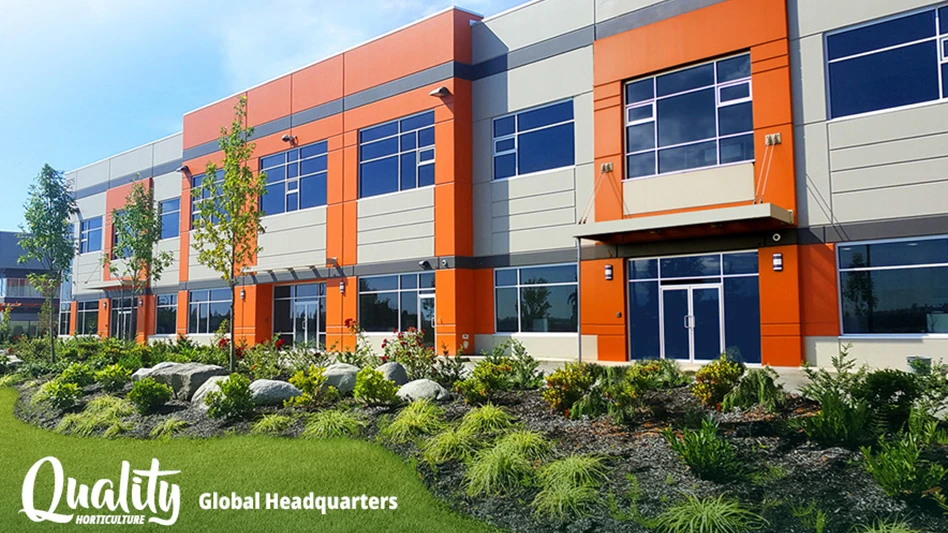Revenue. Acreage. Production quantity. Number of facilities. These are all typical markers of a “big” grower. But what about those producers who are doing great things, but perhaps don’t run as large of an operation? The 2014 Big 10 list comprises growers who have figured out how to be big in their own right, from trying out new production techniques to finding the best way to connect with the rest of the supply chain, from breeders all the way to final consumers. Over the following pages we bring you an inside look at these growers from Alaska to Michigan and Canada to Florida, and other places in between, who are innovating and looking to the future. We’ve divided them out into three categories that best describe the areas in which they stand out: production techniques, producing unique plant material and connecting plants with people. —Karen E. Varga, Editor
Growing with natural resources
Ward’s Greenhouse taps into geothermal heat to improve growing operations.
 You wouldn’t expect to see a greenhouse nestled in the mountains, but that’s where you’ll find Ward’s Greenhouse, across the foothills from Boise in Garden Valley, Idaho. More than 50 years ago, Douglas Ward’s father built a wood-framed greenhouse here and began growing gladiolas and carnations.
You wouldn’t expect to see a greenhouse nestled in the mountains, but that’s where you’ll find Ward’s Greenhouse, across the foothills from Boise in Garden Valley, Idaho. More than 50 years ago, Douglas Ward’s father built a wood-framed greenhouse here and began growing gladiolas and carnations.
The mountain-shaded location presents challenges, from limited sunlight to occasional mudslides. But the Wards prevailed by tapping into the unique geography — specifically, into natural hot water from a nearby creek to generate geothermal heat.
Wanting to leverage natural resources, Ward's father didn’t just build the original greenhouse from wood he cut with a chainsaw. He also built the entire water-heated system inside of it — down to the actual pumps and fans.
“He was a forward looker,” Ward says. “He dug half a mile of ditch with a square-nose shovel in his spare time after work. I remember gathering pistons from the junkyard, and he melted them and poured them into molds he made with plaster. He actually built the pump that used water from a nearby creek, and that water came down and ran the pump so it dished the heat out. He was a true engineer and visionary, and we’re still trying to carry on that tradition.”
Geothermal advantages
The operation has since grown to encompass five acres of enclosed growing space, where a handful of Ward family members work among 25 employees, at peak, to produce bedding plants, hanging baskets and potted flowers. Ward keeps innovating to maximize the competitive benefits of geothermal heat – which differentiates the greenhouse and its products.
“We can use more heat than almost all of our competitors, because we have it available,” Ward says. “This time of year, when it’s getting cold and you’ve got 50,000 poinsettias growing, you don’t have to worry, ‘Should we grow them two degrees colder or should we heat them up and pay the price on heating oil or gas?’ We’re immune to that problem, so we can grow a quality product and we can afford to put more fertilizer into the product because of our savings on heat.”
As a result, Ward says his poinsettias are “bigger, lusher, brighter colored” than holiday plants from big-box stores. The same holds true for other plants, with the most popular sellers being hanging baskets and flats of jumbo annuals. Geothermal heat allows the greenhouse to start perennials early, gaining a head start on plant growth.
 Today, geothermal heat runs through Modine heaters — not car radiators with fans behind them like Ward’s father first built. After it runs through the heaters, heat goes into the floor through a series of pipes buried 10 inches underground.
Today, geothermal heat runs through Modine heaters — not car radiators with fans behind them like Ward’s father first built. After it runs through the heaters, heat goes into the floor through a series of pipes buried 10 inches underground.
“They heat the ground so we have a giant heat bank under the greenhouses,” Ward says. “Considering our location and the snow, we do lose power at times, and during the winter that’s pretty critical. But we have this big heat bank that keeps greenhouses warm while you wait for the power to come back on. That’s something we’ve developed because we need some sort of insurance against power outages.”
By continuing to improve upon the innovative ideas his father envisioned, Ward continues to grow the business. Unfortunately, as efficient as geothermal heat is, it doesn’t allow for much expansion.
“One disadvantage of geothermal heat is you can’t turn it up,” Ward says. “You reach your limit and you can’t haul in more. You’ve got to know when to stop, and that might come to light in another month. In April, you can have the whole five acres planted and keep it plenty warm, then when you get into May and June you turn the water off and turn the fans on. But when it gets really cold, if we had five acres of poinsettias, we couldn’t heat them all.”
Ward’s Greenhouse continues to innovate and grow using available resources.
"You've got to look at everything every year and decide how to change direction," Ward says. "Nothing stays the same and if you're not looking at new plants, new genetics, new methods, you're going to fall behind."

Explore the November 2014 Issue
Check out more from this issue and find your next story to read.
Latest from Greenhouse Management
- North Carolina Nursery & Landscape Association announces new executive vice president
- Plant Development Services, Inc. unveils plant varieties debuting in 2025
- Promo kit available to celebrate first National Wave Day on May 3
- Applications now open for American Floral Endowment graduate scholarships
- Endless Summer Hydrangeas celebrates 20 years with community plantings
- Invest in silver
- Garden Center magazine announces dates for 2025 Garden Center Conference & Expo
- USDA launches $2 billion in aid for floriculture growers





